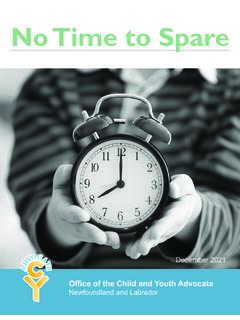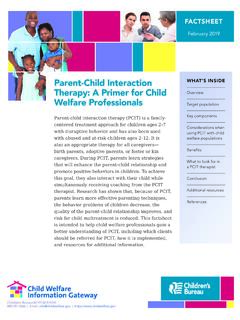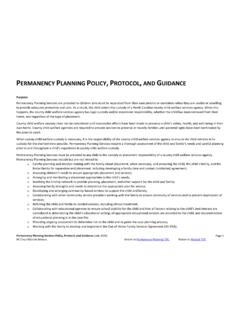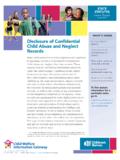Transcription of Financial Assistance for Grandparents and Other Relatives ...
1 Paper originally prepared for Generations United s Second National Symposium on Grandparents and Other Relatives Raising Children July 2004 Financial Assistance for Grandparents and Other Relatives Raising Children NEEDS: Nationally, approximately six million children live in households headed by Grandparents or Other Relatives . About million children live in these households without either parent present, generally putting the relative in the position of raising the A little over 20% of relative-headed households live in Sometimes the grandparent or Other relative caregiver is retired and living on a fixed income. Sometimes they are working, but need help finding and paying for quality child care. kinship caregivers almost never anticipated that they would be raising the children in their care and thus may need Financial Assistance to meet the needs of the children, at least initially.
2 On the Other hand, not all relative caregivers need Financial Assistance . CURRENT RESPONSES: There are several potential sources of Financial Assistance for relative caregivers : (1) Temporary Assistance for Needy Families (TANF);3 (2) foster care; (3) adoption Assistance ; (4) subsidized guardianships and (5) child support payments. Each of these sources of support has advantages and disadvantages and caregivers , as well as those who work with them, need to evaluate which options are available in a given case and which best meet the needs of a particular family. In addition to these supports, social security benefits or tax credits may be available to help certain kinship care families. TANF As the name suggests, Temporary Assistance for Needy Families provides temporary Assistance to families with very low incomes.
3 Each state determines the income eligibility for its TANF program. States also determine the amount of Assistance to be provided to There are two basic types of grants a relative caregiver can receive under TANF. The first is a child -only grant, which considers only the needs and income of the child . Because few children have income or assets of their own, almost all relative caregivers can receive a child -only grant on behalf of the children in their care. Unfortunately, child -only grants are typically quite small and may be insufficient to meet the needs of the child . In 2001, the average grant was about $7 per day for one child , with only slight increases for additional The second type of TANF grant for which relative caregivers may be eligible is a family grant.
4 One of the purposes of TANF is to provide Assistance to needy families so that children may be cared for in their own homes or in the homes of Relatives . 6 Thus, relative caregivers who meet the state s income criteria are eligible to receive a grant that addresses their needs, as well as those of the child . Although these grants are larger than the child -only grants, federal law imposes a 60-month time limit and work requirements on such Thus, TANF family 2grants may not be appropriate for retired relative caregivers or for caregivers who will need Assistance for more than 60 months. Foster Care Payments In addition to TANF, Grandparents and Other Relatives caring for children may be eligible for Assistance through the child welfare system.
5 In most states, kinship caregivers can receive foster care payments on behalf of the children in their care if the children are involved in formal foster care. However, some children are ineligible for such help because Grandparents or Other Relatives stepped in before the child was abused or neglected and thus kept the child out of foster care. Additionally, foster care is intended to be temporary, while permanent plans are made for the child in accordance with the Adoption and Safe Families Act of 1997 (ASFA). Foster payments are typically higher than the TANF child -only payment a grandparent or Other relative could receive on behalf of the child in their care. In fact, the foster care payment is almost always higher than a TANF family grant.
6 Foster payments also multiply ( double, triple) as the number of children cared for increases. However, many relative caregivers who are caring for children who are eligible to receive foster payments prefer not to be involved with the child welfare system. They are uncomfortable with the oversight of the child welfare agency and the court. kinship caregivers may not want to be subject to criminal background checks or home studies and they are often fearful that the agency will remove the children from their homes if disagreements arise. States or counties make foster care payments to foster parents on behalf of children in their care. Sometimes the payments are funded solely with state or county dollars and sometimes the child is eligible for the federal foster care program and states may seek federal funds to cover a portion of the costs associated with those children.
7 Generally, federal foster care payments under Title IV-E of the Social Security Act are available only for very poor Eligibility for the federal foster care program is important because it may impact the amount of Financial Assistance available to relative caregivers . Under federal law, a relative who is a licensed foster parent for a child who is Title IV-E eligible must receive the same foster care payment as non-kin foster All states except, California and Oregon, use state or local funds to provide foster care payments to licensed, relative foster parents caring for children who do not meet the IV-E income criteria. In addition, states may provide Assistance , with state or local funds, to unlicensed Relatives caring for children in foster care.
8 In some states, however, unlicensed relative foster parents are simply referred to TANF for Adoption Assistance Payments Adoption Assistance payments may also be available to relative caregivers who choose to adopt the children in their care. All states provide adoption Assistance on behalf of certain children who are adopted from the child welfare States may receive federal reimbursement, through Title IV-E, for a portion of the adoption Assistance payments made on behalf of very poor children who have special needs. 12 Special needs are defined by the state, but generally include characteristics or conditions that make it difficult to place the child with adoptive parents without a As with foster care, Title IV-E eligibility can make a difference in the amount of the subsidy available and in whether Other benefits, like eligibility for Medicaid, come with the subsidy.
9 3 Subsidized Guardianship For relative caregivers who do not want to adopt the children in their care, legal guardianship can provide the relative caregiver with the rights and authority needed to properly care for Guardianship itself does not address the need for Financial Assistance ,15 but 35 states and the District of Columbia now offer Financial Assistance for Subsidized guardianship programs vary from state to state. Most are available only for Relatives who obtain legal guardianship of children who have been in the foster care system for some period of time. These programs typically require that reunification and adoption be ruled out as options before guardianship Assistance is available. Subsidized guardianship programs may require criminal background checks and home studies.
10 In some states, subsidies for guardians are available only when the children are of a certain age. In a few states, subsidized guardianships are available only for children with special needs or for children who meet certain income tests. Typically, subsidized guardianships are subject to only minimal oversight ( an annual report to the court or an annual meeting with the child welfare agency). The amount of the subsidy varies from state to state. Usually, the subsidy amount is somewhere between the amount of a TANF child -only grant and a foster care Federal dollars are generally not available to provide guardianship subsidies, but seven states have gotten waivers from the federal government to use Title IV-E funds to provide such child Support Payments Until a court has terminated parental rights, a parent generally remains financially responsible for his or her children.





